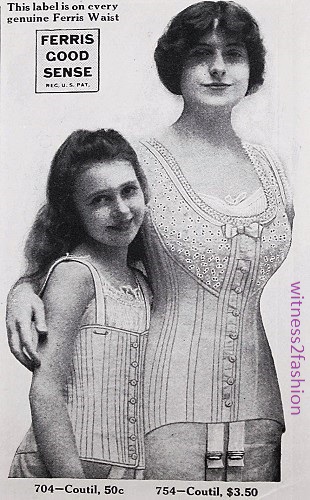
Mother and daughter both wear Ferris Corsets in this ad from March, 1914. Delineator, page 65.
The Ferris Corset Waist was often stiffened by channels of cording, rather than exclusively by steel bones. In its day, it was a sort of “reform” or “good sense” garment, more flexible and less rigid than the usual boned corset. Nevertheless, it’s dismaying to read:

“Made in more than 100 styles to properly fit all ages, infants to adults.” Ad for the Ferris Waist; Delineator, March 1914.

The full ad for Ferris Waists, March 1914.
The girls at the bottom seem to be teens. The one at left appears to be leaning forward while using some kind of exercise equipment.

The tiny waist at left seems more 1910 than 1914. It may have been a “sport” corset.
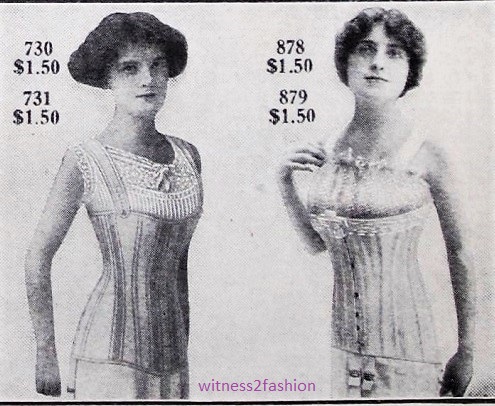
The straps help to “teach” correct posture — and hold up your stockings. Even young girls needed something to hold their stockings up… especially when they were too young to have a waist and hips.

Text of Ferris ad, March 1914. “Ferris Waists take the place of corsets.”
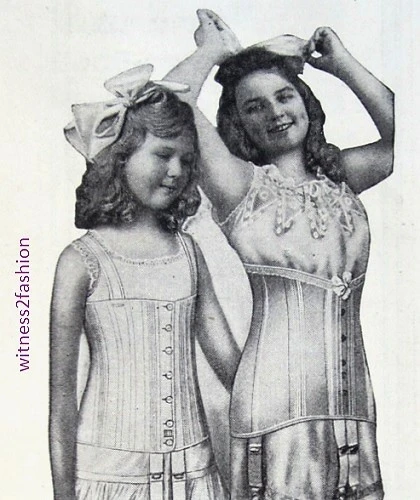
Two girls wear Ferris waists in this ad from April 1917.

Ferris Good Sense Corset Waists were “lightly boned and beautifully corded” to naturally develop the growing body into a more perfect figure in later years.” Ad from April 1917. Delineator.
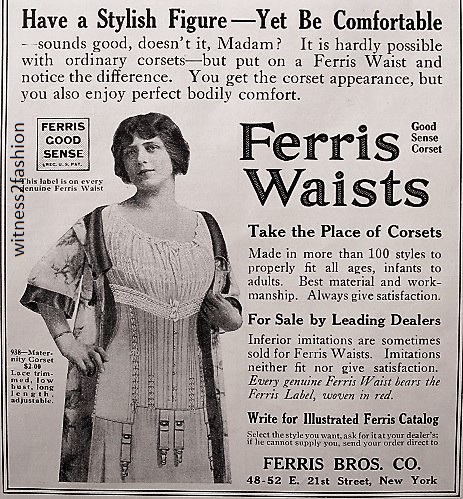
Ad from May, 1914, featuring a maternity corset. Maternity corsets were sold by several companies, including Lane Bryant [click here to read more about Lane Bryant;] Sears, Roebuck; and Berthe May.

Ferris Maternity Corset, May 1914. Delineator, page 73. [Why is she wearing her slip under her corset? Because the upper thigh was not usually shown in ads even in the 1950’s, which always led me to wonder how those stocking suspenders reached the stocking tops.]
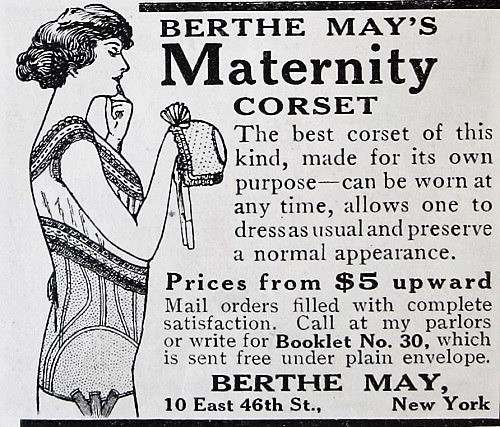
A rival to the Ferris maternity corset was this more traditional boned corset from Berthe May. January 1914, Delineator. It “allows one to dress as usual and preserve a normal appearance.”
In this ad from 1910, Ferris assured buyers that their products were made “under the cleanest conditions.”

Ferris assured women that the Ferris Good Sense corset waist was not made by exploiting women workers in sweatshop conditions or by piecework in tenements. Ferris ad, 1910.
However, this Ferris maternity corset from 1910 does show fashionable constriction of the waist:

A Ferris Good Sense maternity corset/waist from 1910 clearly was intended to maintain the then-fashionable hourglass figure as long as possible.

Ad for Ferris Waists from Delineator, May, 1910.

Ferris ad, May 1910.
“Good sense” or not, corset-wearing started early:

Ferris Good Sense Corsets for girls, starting at age 6 months. If it buttoned up the back, a girl couldn’t get out of it without help.

Ferris Good Sense corsets for girls and teens, 7 to 15 years old. “[…Pleated] busts soft as silk. Specially adapted to growing girls 11 to 15 of slender form.”

Ferris waist for girls 12 to 17. May 1910 ad.
Those hose supporters (stocking suspenders) are really long!

An adult corset from 1910 sold by waist size: 19 to 30 inches. Ferris ad, Delineator, May 1910.
You can read more about the Ferris Brothers here.

This is absolutely amazing, I have never seen corsets for such young girls before. Those maternity corsets make me so anxious, I have so many follow up questions. Thanks for the great work!
European and American girl-children from the upper classes were corseted in the 17th century and probably earlier. One side effect was that their own muscles (“core strength,” they call it at the gym) didn’t develop fully, so that they got back-aches if they didn’t wear the corsets they were used to. The maternity corset presumably helped such women (in addition to concealing pregnancy for a while, when even married women were advised to avoid public notice and stay at home once their condition became obvious.)
Reblogged this on fashion for legs.
Looks a little like kiddie porn to me. Good grief!
Oh, dear! I don’t read these ads from a “woman’s magazine” as intended for the male gaze, but I do note that corsets were inflicted on girls by their mothers — like far worse customs, from foot-binding to female circumcision. Women who fully understood the suffering, from personal experience, forced it upon their daughters — a side effect of assuming that women must become wives.
My cousin (who would have been 105 this year) was one of those children whose mother corseted her from childhood. Her comments on full length girdles stick with me: ‘they were the less stupid version of stupid’. It was a class and era specific custom. Like foot binding, it indicated you were not required to work for a living. The maid didn’t wear one, but you weren’t going to be a maid, so let the maid lace you up.
My mother was born in 1906 to a middle class family, probably lower middle class, her father was a piano tuner and technician. I don’t remember her ever mentioning wearing a corset, and she definitely didn’t wear anything like it as an adult. My grandmother, on the other hand, wore a corset, but never laced it tightly. Looking at old photos I don’t think she did. But to give it up would be like leaving your underpants at home ….
bonnie in provence
That’s a great analogy! My grandmother, born in 1875, wife of a plumber, was still wearing a corset when I lived with her in 1950. It was rather like a 1917 corset — she wore a bra with it, since it didn’t come up much past her waist. I’m sure its purpose was support, not fashion. Hugging her felt like I was putting my arms around a warm, loving barrel!